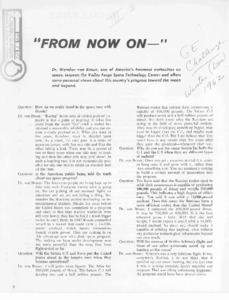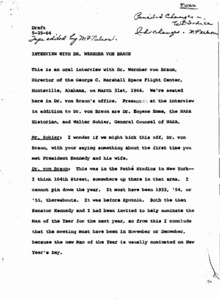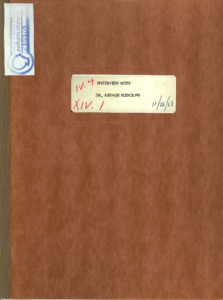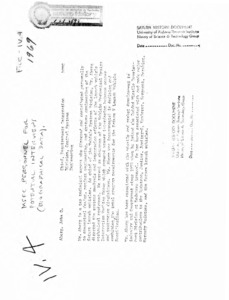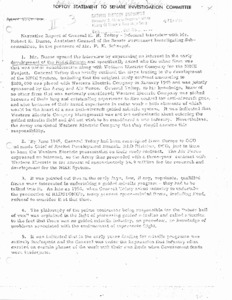
Browse Items (113 total)
Sort by:
-
"Human Performance Issues Arising From Manned Space Station Missions."
This is a series of interviews with various anonymous astronauts from various programs including Skylab, focused on the future of manned spaceflight. -
"From Now On -."
Interview with Dr. Wernher von Braun; Challenge, Winter(Dec) 1962, volume 1, number 3 -
"Interview with Dr. Wernher von Braun."
Transcription of an interview with Wernher von Braun and Mr. Sohier. -
"Interview With Dr. Arthur Rudolph."
Transcription of an interview between Davis S. Akens and Arthur Rudolph -
"Marshall Space Flight Center personnel for potential interviews."
Photocopy. A collection of interviews and biographical data. -
"Toftoy statement to Senate Investigation Committee": Development of the Nike system.
Narrative report of general H.N. Toftoy - Informal interview with Mr. Robert E. Dunne, Assistant Counsel of the Senate Permanent Investigating Subcommittee, in the presence of Mr. P. K. Schaeppi. -
"We're winning the race with Russia."
Partial article discussing the United States' victories in the space-race over Russia. -
Oral History Interview With Richard Heckmann
Richard Heckmann was born in Ohio, and he lived there until he was 9 years old. When he turned 9, his dad received a civil engineering job in Washington D.C., so they moved there soon after. After this, they then moved to Maryland. Richard explains that he was a sickly child, and he was once in a coma for 10 days when he was just 7 years old. Growing up, he became more healthy and ended up going to Johns Hopkins University and graduated with an Engineering Science degree. Richard eventually accepted a commission in the ordinance corp, and he went to Fort Bliss for a guided missile school. He spent two years in the autillery there. At Fort Bliss, he received his private pilot's license while he was in the service. Then, they took Richard back to the ordinance corp. and they sent him down to the Redstone Arsenal, where he got stationed. After this career, Richard worked as a project engineer for the manufacturing for hardware at Thiokol. He then transferred to Hayes Industry, and he worked with the manufacturing engineering lab at the Marshall Space Flight Center. There, he worked on the Apollo Applications Program.Tags Oral History -
Oral History Interview With Charles Van Valkenburg
Charles Van Valkenburg grew up in Huntsville, AL, and he went to Auburn University. There, he majored in Industrial Design and he had a part-time job as a draftsman at one of the civil engineering firms. After graduating college, he received a job at Essex in Huntsville. At this job, Charles would get in the water of the Neutral Buoyancy Tank and make sure that all the tools and everything was in place for an astronaut. Sometimes, he would even be the test subject. After all the testing from the day, they would all have a debriefing session at this company where the astronaut, human factors experts, and engineers would all make inputs. After the debriefing, they would take the ideas and get the machinists to make some modifications to the hardware. Charles would also work in pressure suits, and he explains how restricted the suit made him feel. He also mentions the foot restraints, and how difficult they were to work with. In his career, Charles was also able to help design the underwater version of the manned maneuvering unit.Tags Oral History -
Oral History Interview With Edwin Pruitt
Edwin Pruitt is from a small town in Alabama. He went to Auburn University, and when he was a sophomore there, he applied to a co-op position. In this co-op, he was assigned to a flight-dynamics group. Edwin was not satisfied with this position, so he asked to be switched to another one. In this new co-op, he was able to drive around on the simulated moon surface. Some things he was also involved in was diving into the Neutral Buoyancy Simulator, flying on the KC-135, and he had the freedom to represent his group with other part of the center where he worked. After Edwin graduated from college, he got a job at GE Aerospace in Valley Forge. They had a contract with the Airforce to train the Airforce astronauts. He eventually got laid off from this position, and he next got a job at Teledyne Brown Engineering. After working there for a couple of years, he found a job at Matrix in Huntsville. After working here, he found a job at Essex working on proposals.Tags Oral History

